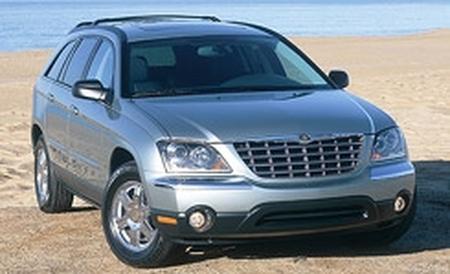Our test car had comfortable leather seats that seemed an appropriate match for the lavish interior design that combines realistic faux-wood panels with silver-colored trim and high-quality moldings. Our vehicle also had a navigation system with its display screen in the speedometer face. That, says Chrysler designers, allowed them to design a conventional console without having to accommodate a large screen that is a blank waste of space when not in use.
They also cite better ergonomics, with the driver looking straight ahead when consulting the map. But the display is smaller than most others. Moreover, it’s not easy to see when driving with sunglasses, and its position prevents the passenger from handling navigation chores. But it looks cool, particularly since the speedometer needle floats in space as if there were no stem to its pointer. Very trick. And the navigation system itself is logical in operation, with sensible menu-driven shortcuts for entering addresses.
The rest of the gauge and dash layout is tidy and easy to use, too, although there seems to be an inordinate number of buttons. There are five buttons on the wheel to manage the cruise control. But the stereo system has sliders for balance and fade and knobs for treble and bass that we like better than multiplexed controls.
With its pioneering experience in minivans, Chrysler has done a great job with the interior accommodations and attendant safety issues. As well as three-stage front airbags, there are curtain airbags that serve all three rows. In addition, there is an inflatable driver’s-knee cushion to help prevent leg injuries as well as position the driver for optimal airbag and seatbelt operation.
That’s all well and good, but C/D readers are more interested in performance and driving pleasure. In that respect, the Pacifica ought not to disappoint anyone whose priorities drove him or her to a big people mover. Its acceleration times are roughly the same as those of the Lincoln Navigator and not much slower than those of a 3.0-liter BMW X5. Furthermore, the 3.5-liter V-6 seems more than adequate in the cut and thrust of rush hour, even if its high-rpm endeavors occasionally sound a bit labored.
Although the test numbers appear adequate–they’d probably be better in a front-wheel-drive model–it’s obvious that a fully laden Pacifica AWD will have its work cut out on a mountain pass. There’s only so much 250 horsepower can do with a 4720-pound “sport tourer.”
Nonetheless, the standard-equipment AutoStick manumatic brings a touch of sportiness to mountain driving, enabling the driver to hold gears and even add engine braking to the repertoire. When in manual mode, the Pacifica will run to the 6500-rpm redline in the lower two gears and will shift up automatically before hitting the 6800-rpm rev limiter. In third gear, for some reason, the system shifts up at 5500 rpm regardless.
Given its hefty size and weight, the Pacifica handles with commendable poise. The steering offers crisp off-center response and fairly linear gain as you wind the lock on. Consequently, you can aim the Pacifica through gaps not that much wider than the vehicle itself with a good chance of emerging unscathed.
Although the chassis has been tuned for long-distance comfort and is fairly soft, the Pacifica has well-damped ride motions, and it takes a firm set in hard corners. The Mercedes-derived five-link rear suspension works transparently, providing good straight-line tracking with neutral rear-wheel steering input. The only obvious shortcoming in the suspension is a front end that transmits a fair amount of bump thump and rumble, along with vibration from rippled surfaces. Considering the impact absorption expected from the vehicle’s relatively high-profile 65-series tires, that was a bit disappointing.
But this is a large-capacity personnel transporter and, as such, is remarkable for the amount of confidence it endows a driver in urban environments. We found ourselves jack-rabbiting about in the same way we would in smaller, sportier cars, despite the Pacifica’s somewhat spongy brake-pedal feel and 182-foot stopping distance from 70 mph. Somehow, the rock-solid structural rigidity, the chassis integrity, and the steering accuracy team up to produce an honest–if slightly isolated–driver environment.
There’s a real sense of quality in much of what the Pacifica does. Its switches and controls feel substantial; the Hella headlights cast a bright and clearly defined pattern; the stereo is loud and clear (although the radio tuner prefers strong signals); and the leather steering-wheel rim has a pleasing shape and texture.
Even at 198.9 inches in length, the Pacifica has a reasonably intimate ambience inside. Perhaps because of the way the interior panels are shaped and contoured, it never feels like a bus. The third-row seats in particular have deep window surrounds that lend a friendly grottolike atmosphere. The kids should like it. But in case the thick D-pillars and nonopening windows produce claustrophobia, there’s an optional DVD-based entertainment center to distract them. And if the DVD video system reminds you too strongly of a minivan, just repeat this mantra: sport tourer, sport tourer, sport tourer. See the difference now?
ÃÂ
View Photos
View Photos


Leave a Reply